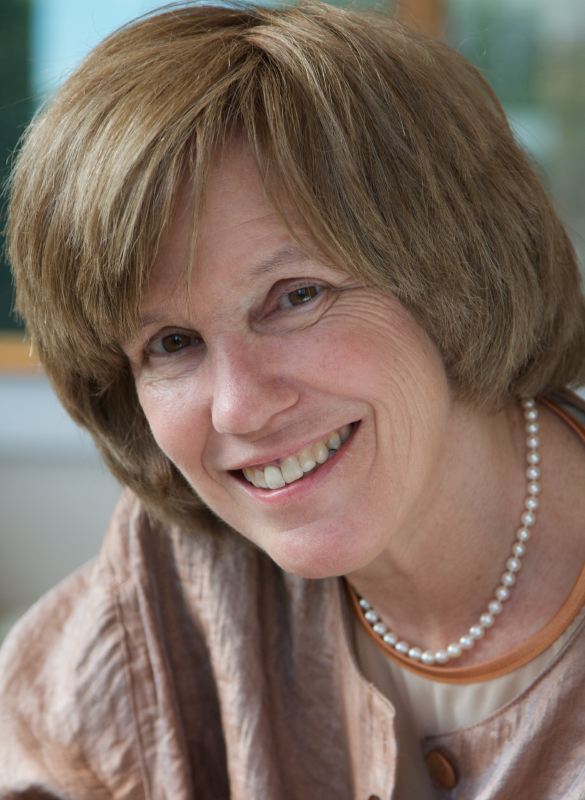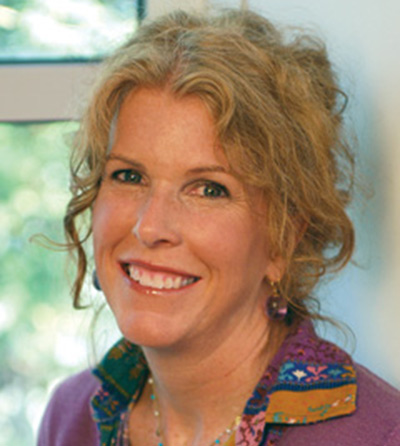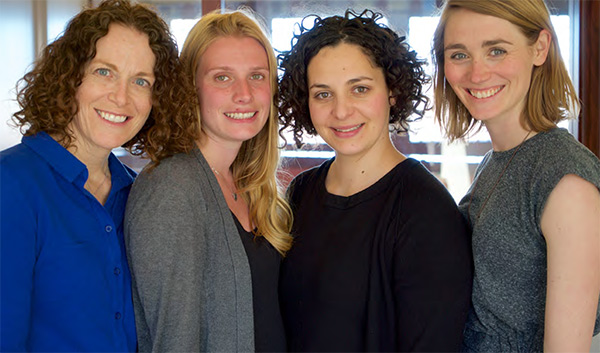Judging Books – They’ve Got It Covered: The TC Reading and Writing Project and Heinemann team to create classroom libraries to order
You’re a third-grade teacher with a class full of kids from different backgrounds who read at different levels. You want to offer them something a little more joyful than “instructional materials”: the experience of getting lost in a good book. But you don’t know what’s out there or how to choose for such a diverse group.
Wouldn’t it be great if a bunch of experts could put your classroom library together for you?

“When you open a box of books and you know each and every book has been read by a huge cadre of people you absolutely trust, your whole relationship to a book changes. Is the first chapter too slow? Is the cover really bad? Keep going – there’s a great book inside.”
—Lucy Calkins, Robinson Professor of Children's Literature, and TCRWP Founding Director
Now they have. This past summer, Heinemann, a leading publisher of professional development books and provider of resources for teachers, introduced The Teachers College Reading and Writing Project (TCRWP) Classroom Libraries Series – books for grades K-8 selected and vetted by the nation’s leading provider of literacy professional development for teachers.
“This is the largest library of its kind,” says Lucy Calkins, Director of TCRWP and TC’s Robinson Professor of Children’s Literature. “People are moving from buying core reading programs to wanting children to read real literature, but they don’t know how to do it. But when you open a box of books and you know each and every book has been read by a huge cadre of people you absolutely trust, your whole relationship to a book changes. Is the first chapter too slow? Is the cover really bad? Keep going – there’s a great book inside.”
Calkins, who also co-directs TC’s Literacy Specialist Program, is the author of the best-selling new grade-by-grade Units of Study for Teaching Reading, Grades K-5 and Units of Study in Opinion/Argument, Information, and Narrative Writing, Grades K-8 series. Her other books include The Art of Teaching Writing; Pathways to the Common Core: Accelerating Achievement; and The Art of Teaching Reading.
Expert Judges
Founded by Calkins more than 30 years ago, TCRWP works in thousands of classrooms and schools around the world, supporting teachers, administrators, and school change agents with professional development, curriculum and instructional methods. More than 170,000 teachers have attended the Project’s week-long institutes, and over 4,000 participants return each year for annual Saturday Reunions. In schools that work closely with TCRWP in New York, where the organization is most active, 20 percent more students performed at or above standards on the state’s English Language Arts test in 2016.
Drawing on books from more than 50 different publishers, the Heinemann/TCRWP series offers each grade two libraries – one for kids who read on grade level, the other for those who read significantly below it. Each library contains anywhere from 450 to more than 700 titles, spanning fiction and nonfiction and genres that include classics, sports, science, mystery, fantasy, biography and history. Every book has been chosen to turn a child into a reader.
“The theme of this whole project is to get kids to fall in love with reading,” Lucy Calkins says. “Trade libraries tend to publish for kids who already love to read. But there are hundreds of thousands of kids who read below grade level, and so often schools just end up giving up on them. We’re saying, No, that can’t be allowed to happen—so we’ve just got to find books with relevant, interesting themes to reach them all.”
The project has a strong social justice component on other levels as well.
“I’m here because [the late Teachers College professor and philosopher] Maxine Greene took me to a school with about 380 entering freshman that graduated just 30 kids – and there was not one book anywhere in the school that kids could read, or wanted to read,” says Mary Ehrenworth, TCRWP’s Deputy Director of Middle Schools and co-author with Calkins of Pathways to the Common Core. “There are schools all over that would put books in kids’ hands if they only knew which ones. Now those kids will get books because we’ve made it easy. Also, teachers tend to use the books they know by heart. As a result, there’s not a lot of discovery there. So we’re getting a more diverse group of authors into schools. It’s an act of social justice, particularly because too many of the kids who most need real books sometimes tend to get workbooks, and not real books.”

“Teachers tend to use the books they know by heart. As a result, there’s not a lot of discovery there. So we’re getting a more diverse group of authors into schools. It’s an act of social justice, particularly because too many of the kids who most need real books sometimes tend to get workbooks, and not real books.”
—Mary Ehrenworth, TCRWP Deputy Director of Middle Schools
According to figures presented at Neilson Books’ annual Children’s Book Summit in 2015, while print sales of adult fiction and nonfiction have dropped in the United States, the juvenile market has grown 40 percent in the last decade. Between January 2014 and September 2015, children’s book sales increased by more than 12 percent in the United States, 28 percent in Brazil, and 10 percent in China. Thanks in part to e-books, kids also are reading earlier.
In light of those trends, Calkins says, the TCRWP libraries series is providing an especially valuable service because it brings to bear a range of perspectives that no other library service offers, from multiculturalists to experts on sentence structure. Those features are sufficiently attractive that in at least one state, there is talk of passing legislation that would provide funding for classroom libraries.
The TCRWP initiative could also create a feedback loop to publishers that will result in even better offerings for young people.
“It’s been very interesting to look at the diversity of books,” Calkins says. “Now we know what needs to be written. Many of the books with diverse protagonists are picture books, but kids need novels. We need it in mainstream categories – mystery and fantasy.”
Breaking New Ground
There have been previous efforts to create off-the-shelf classroom libraries, but as Anita Silvey, publisher of children’s books for Houghton Mifflin Company from 1995-2001 and former Editor-in-Chief of The Horn Book (a leading journal in the field of children’s and young adult literature), explains in a blog on the Heinemann site, they have been limited by the necessity of acquiring the rights to reprint popular titles from multiple publishers.

The TCRWP Series was nearly a year in the making. Calkins and her team – including Norah Mallaney and Molly Picardi, both 2016 graduates of TC’s Literacy Specialist program and current New York City teachers – solicited recommendations from more than 350 teachers, library coordinators, mentors and writers of children’s literature, as well as from young people themselves. Then they filled a room in the basement of TC’s Horace Mann Hall with more than 20,000 review copies of books provided by leading publishers for children and teens. Each title was read and ranked by as many as 22 different team members.
“In judging these books we looked for beautiful use of language, high standards of art, and impressive and exhaustive research, preferably in primary documents,” writes Silvery, who also served as a TCRWP reviewer. “In fact, we argued passionately about the inclusion, or exclusion, of a particular title or series. This was a time when I was happy to be, to use a line from Hamilton, ‘in the room where it happened.’”
“In judging these books we looked for beautiful use of language, high standards of art, and impressive and exhaustive research, preferably in primary documents. In fact, we argued passionately about the inclusion, or exclusion, of a particular title or series. This was a time when I was happy to be, to use a line from Hamilton, ‘in the room where it happened.’”
—Anita Silvey, TCRWP reviewer, former publisher of children’s books for Houghton Mifflin Company and former Editor-in-Chief of The Horn Book Magazine
Something Old, Something New
Certainly all the stalwarts of children’s literature are here. C.S. Lewis’ Narnia chronicles; Pippi Longstocking; Harry the Dirty Dog; The Snowy Day; A Wrinkle in Time are all represented, as well as newer classics such as the Harry Potter books, The Hunger Games, The Invention of Hugo Cabret and the Artemis Fowl series. But there are hundreds of other titles, ranging from Mark Kurlansky’s Cod: A Biography of the Fish that Changed the World, to Sharon Draper’s Romiette and Julio, a retelling of Shakespeare’s play that illuminates tensions between African Americans and Latinos in modern-day America.
Other titles include:
- Houses Around the World, by Judy Nayer, and Jobs People Do, by Pam Holder (from the kindergarten benchmark list);
- Toilet: How it Works by David Macaulay, and Baseball Saved Us, by Ken Mochizuki – a story of growing up in the U.S. internment camps for Japanese-Americans during World War II (from the Grade 3-5 Benchmark list);
- Life Doesn’t Frighten Me, by Maya Angelou; Endangered Tigers, by Bobbie Kalman; and The Name Jar, by Yangsook Choi (from the Grade 3 “below benchmark” list);
- Almost Astronauts: 13 Women Who Dared To Dream, by Tanya Lee Stone; How They Croaked: The Awful Ends of the Awfully Famous, by Georgia Bragg; and Jefferson’s Sons, by Kimberly Bradley (from the Grade 6 Benchmark List);
- I Hadn’t Meant to Tell You This, by Jacqueline Woodson, about an interracial friendship between two girls who are dealing with secrets and violence, and 13: Thirteen Stories That Capture the Agony and Ecstasy of Being Thirteen, edited by James Howe, which includes the story of a first kiss and a boy’s realization about his sexual orientation (from the Grade 7 benchmark list);
- Pedro & Me, a graphic novel by Judd Winick; The Secret Life of Bees, by Sue Monk Kidd; All The Light We Cannot See, by Anthony Doerr; Boy in the Striped Pajamas, by John Boyne; Drowned City: Hurricane Katrina & New Orleans, by Don Brown; Remember Beirut, by Zeinia Abirached; and Game Changers, by the sports writer Mike Lupica (from the Grade 8 benchmark list).
Certainly there are some controversial titles, but “We don’t think it’s our jobs to protect kids from books,” Calkins says. “We’re very careful about graphic sexuality. But really, Harry Potter and The Hunger Games changed the face of children’s literature. They showed us kids could handle reading about serious issues, loss and the courage to face injustice.”
Ultimately, Calkins says, the goal is for the range of material to offer each and every child a pathway to loving reading.
“Think of how much this nation spends on reading – but not on books for children,” she says. “But if we choose the right books, the books will teach them.” – Joe Levine
Published Monday, Nov 7, 2016